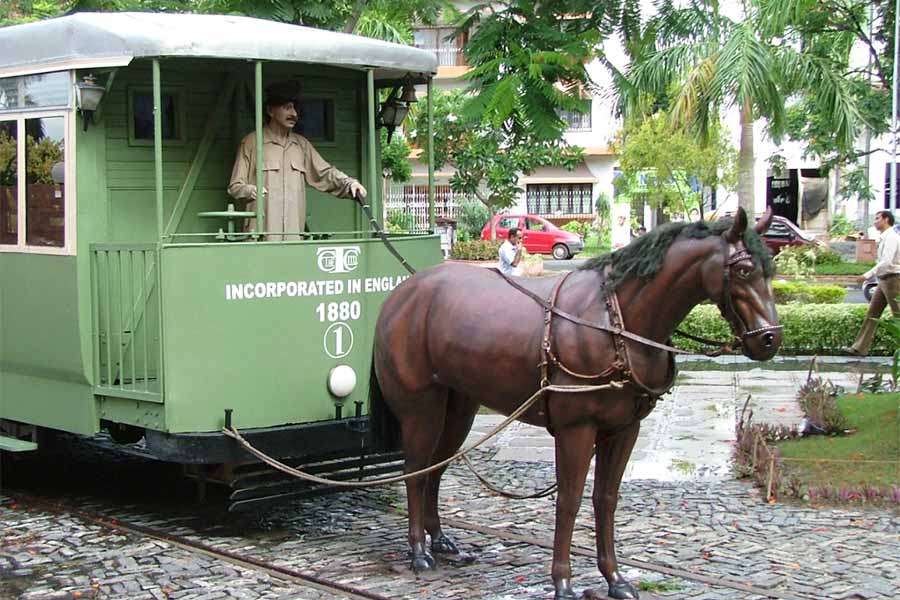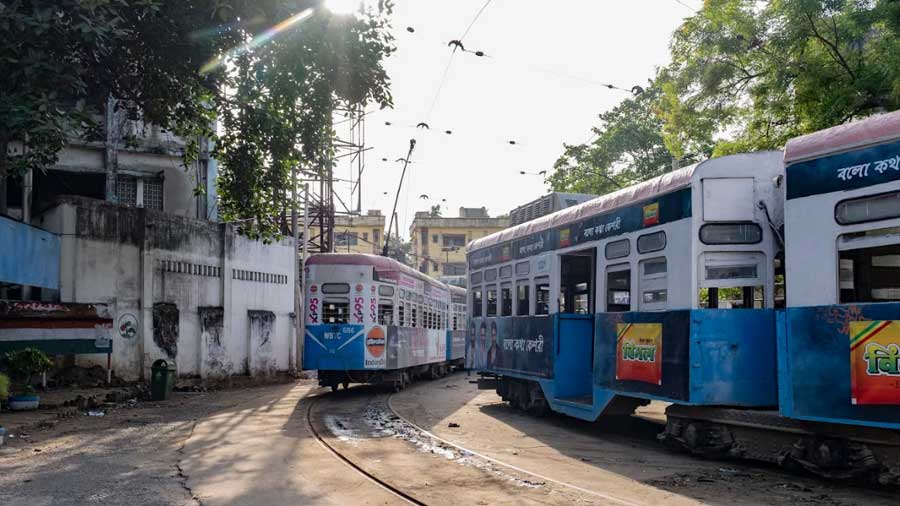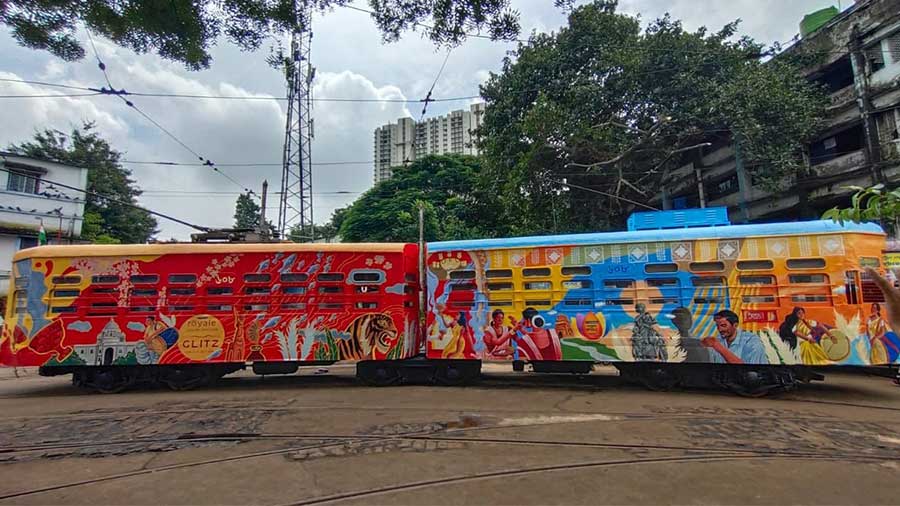The trams of Kolkata are in their last lap, it seems. In a world defined by breakneck speed, the leisurely pace of operation of these vintage transport forms, stand out.
From its heydays when these carriages crisscrossed almost the entire metropolis, active routes have dwindled to two at present, both starting from Esplanade – one northbound to Shyambazar, and the other headed to Ballygunge in the south. Their days are also possibly numbered. But I write today not to dwell on the impending demise of one of the city’s most beloved symbols but to shed some light on the time on its genesis.

Early electric trams ply on Chitpore Road Wikimedia Commons
The year was 1867. The Bengal government, in recognition of the burgeoning population and commercialisation of the city, passed an act to install tramlines in Calcutta. The power of execution was handed to the Justices of Peace – the group of learned men who were in charge of running the Calcutta Municipal Corporation. Progress was slow, however.
Nearly three years later, on March 20, 1870, a missive was sent by the central government to the Bengal administration highlighting the need of a rapid and organised transit system to move commodities from Sealdah station to the rest of the city and onwards. Now, the ball started rolling. The Bengal government formed a committee to oversee the matter whose findings report was tabled with the central government. In March, 1871, approval arrived from the Viceroy’s office to initiate work.
It was initially decided that the most pressing need was to transfer commodities, primarily agricultural, arriving in Sealdah, to warehouses at Strand Road and Sovabazar area. Thus, it was decided by the Justices Committee to propose an experimental line connecting Sealdah with the ghats near Bowbazar, from there onwards northwards to Armenian and Ahiritola ghats and carrying on through to Sovabazar, terminating at the Chitpore pool (bridge). However, the Bengal government only permitted track from Sealdah to Armenian ghat and allotted Rs 1 lakh for the same.

Trams of British India Wikimedia Commons
Armenian Ghat was a vital connecting link. The ticket house for East Indian Railway’s Howrah terminus was situated there. Thus, a tramline starting (culminating) there would be vital in joining Sealdah and Howrah. In the end, actual expenses overshot the budget by Rs 50,000. The track began at Sealdah and proceeded along Baithakkhana, Bowbazar Street, Dalhousie Square, Strand Road and terminating at Armenian Ghat. The first tram, drawn by horses, ran on February 28, 1873.
An eyewitness account recalls the momentous occasion — the first car, with two carriages: one first and one second class, had five passengers in the former, three Europeans and two Indians. The second one saw a packed house. As the trams passed through Dalhousie Square, huge crowds thronged both sides and cheered lustily. However, the euphoria did not last long. After incurring monthly losses of Rs 900 for nine months, the Sealdah – Armenian service was stopped, the last service running on November 20, 1873. The tracks and carriages were sold off to two gentlemen by the names of Parish and Souttar.

A model of a horse-drawn tram Wikimedia Commons
Five years later, some entrepreneurs and businessmen of the city submitted proposals to run tram services in the city. Among them was M/s Parish & Souttar, who had bought the carriages from the government and who were awarded the contract. The two gentlemen formed an entity called The Calcutta Tramways Company (CTC). The company acquired the tracks, carriages and the awarded rights from Parish and Souttar for a payment of four thousand pounds. By a contract signed between the Bengal government and Calcutta Tramways Company in 1879, the latter were permitted to ply their trams in the following areas:
- Sealdah station to Dalhousie via Bow Bazaar Street
- Chowringhee Road
- Chitpore Road (present day Rabindra Sarani)
- Dhurumtolla Street (present day Lenin Sarani)
- Strand Road
- Shyambazar
- Kidderpore
- Wellesley Street (present-day Rafi Ahmed Kidwai Road)
The first tram of Calcutta Tramways Company rolled out on October 29, 1880, on the Sealdah – Bowbazar route. The second route activated was the extension of the first to Dalhousie Square and Hare Street on November 19, 1880. The remaining routes were activated and all were operational by 1884. Every carriage was pulled by a pair of Weller horses. The first six depots of CTC, operational by 1896 were Shyampukur, Chitpore, Sealdah, Colinga (Dhurumtolla), Bhowanipore and Kidderpore. The cars and horses were kept at these depots. As of 1890-91, CTC had in its books 2,250 workers and 1,000 horses.
In 1896, the Kilburn Company applied for permission to operate trams fuelled by electricity. In 1899, a contract was finalised for migration from horse-drawn to electricity-driven trams. The first electric-driven tram rolled out of the Kidderpore depot on March 27, 1902. The first-class fare for a trip from Kidderpore to Esplanade was 2 annas. On 14th June, the next electric line was operational in the Kalighat sector. By end of November, 1902, all lines had migrated to electricity. The stage was set for a rapid expansion.

Kalighat and (right) Esplanade tram terminuses Wikimedia Commons
Between 1903 and 1908, the tramways expanded to Tollygunge, Belgachhia, Bagbazar, Harrison Road (Mahatma Gandhi Road), Lower Circular Road (AJC Bose Road), Alipore and Behala. On July 7, 1905, an electric tram rolled from Sealdah to Calcutta High Court – the first electric tram journey on Strand Road along the river. The Sealdah to Rajabazar line was opened in 1910, the Sealdah – Park Circus line in 1925, the Rashbehari Avenue line in 1928, Rajabazar to Shyambazar line in 1941 and Park Circus to Ballygunge line in 1943. By the time of Independence, trams were the mainstays of the city’s public transport system.
Those heydays are gone. Practicality calls for an end to these relics from a time long lost. Yet, the heart doesn’t agree and sincerely wishes that some solution is found which will ensure that our city doesn’t lose one of its most prominent identities.
Source: Kolikata Dorpon (Prothom Porbo) – by Radha Raman Mitra



